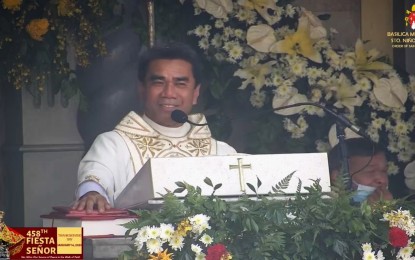
THANKSGIVING. Msgr. Rogelio Fuentes, team moderator at the Shrine of the San Nicolas de Tolentino Parish in Barangay San Nicolas-Proper, delivers the homily during the thanksgiving mass for the Sr. Sto. Niño on Monday (Jan. 16, 2023). Fuentes reminded the devotees of the connection of the Augustinian Friars at the 457-year-old Basilica and San Nicolas, known the "mother of parishes" in mainland Cebu and "el primer pueblo de Filipinas” or the first town in the Philippines established by the Spaniards. (Screengrab from the Basilica Minore del Sto. Niño video)
CEBU CITY – Parishioners of the San Nicolas de Tolentino Shrine in a village known during the Spanish time as “el primer pueblo de Filipinas” or the first town in the Philippines on Monday joined the devotees of the Sto. Niño in celebrating a thanksgiving mass.
Diocesan priest, Msgr. Rogelio Fuentes, San Nicolas shrine’s team moderator, traced the thanksgiving celebration at the 457-year-old Basilica Minore del Sto. Niño to the relationship between the friars of the Order of St. Augustine (OSA) and the residents of the country’s oldest pueblo.
“Long before the pandemic, the priests from our parish would be called to celebrate the thanksgiving mass. Why is that? Perhaps, it is because of so many connections between the Basilica and San Nicolas Parish,” Fuentes said in his homily.
He reminded the devotees that San Nicolas, as the old settlement during the Spanish time and at the same time the first parish ever established in mainland Cebu, was founded by the Augustinian friars who were Spaniards in 1584.
As the mother parish, San Nicolas was instrumental in creating major parishes in Cebu like the Sta. Catalina de Alexandria in Carcar City (1617), Nuestra Señora Virgen de la Regla in Lapu-Lapu City (1711), San Francisco de Asis in Naga City (1829), Sta. Teresa de Avila in Talisay City (1836), Sto. Tomas de Villanueva in El Pardo, Cebu City (1933), Our Lady of Guadalupe de Cebu in Guadalupe, Cebu City (1933), and five other parishes here.
On Visperas Saturday every Fiesta Señor, the image of the “Sto. Niño de Teniente” from San Nicolas will have to arrive to guard the Basilica for the entire duration of the solemn foot procession of the holy image of the Sr. Sto. Niño de Cebu.
As a tradition, Fuentes said the Augustian friars are the ones who celebrate the fiesta concelebrated mass in honor of the Our Lady of Consolacion, San Nicolas parish’s second patron saint.
Fuentes, who also is serving as Archdiocese of Cebu vicar general, said he finds it proper that as the oldest of all the parishes in Cebu, the parish priest in San Nicolas would lead the holy mass in thanking God for the three graces – the grace of history, the grace of the celebration, and the graces that each one received from the Lord.
“In the grace of history, we have many things to thank about as we have just commemorated the 500 years of Christianity, a grace that Cebuanos are grateful to God for it is in our midst that the blessing of this Basilica and the image of the Sr. Sto. Niño gifted to Queen Juana on the occasion of the first baptism here in Cebu,” he said in Cebuano.
According to a publication, Balaanong Bahandi, the San Nicolas church built in honor of an Italian saint, St. Nicolas de Tolentino, also served as a town known before as Cebu el Viejo or old Cebu back to the time of Miguel Lopez de Legazpi, 439 years ago.
The adjacent settlement up north was Villa San Miguel, the city created by the Spaniards while farther away was called Parian where the Chinese lived and traded.
The San Nicolas church was built between 1787 and 1804 under the supervision of Augustinian friar Ambosio Otero. The bell tower was added in 1812 and the parochial house in 1825.
However, the church building was destroyed by aerial bombing during World War II.
The present-day church was built in 1942 and finished in 1965. (PNA)
